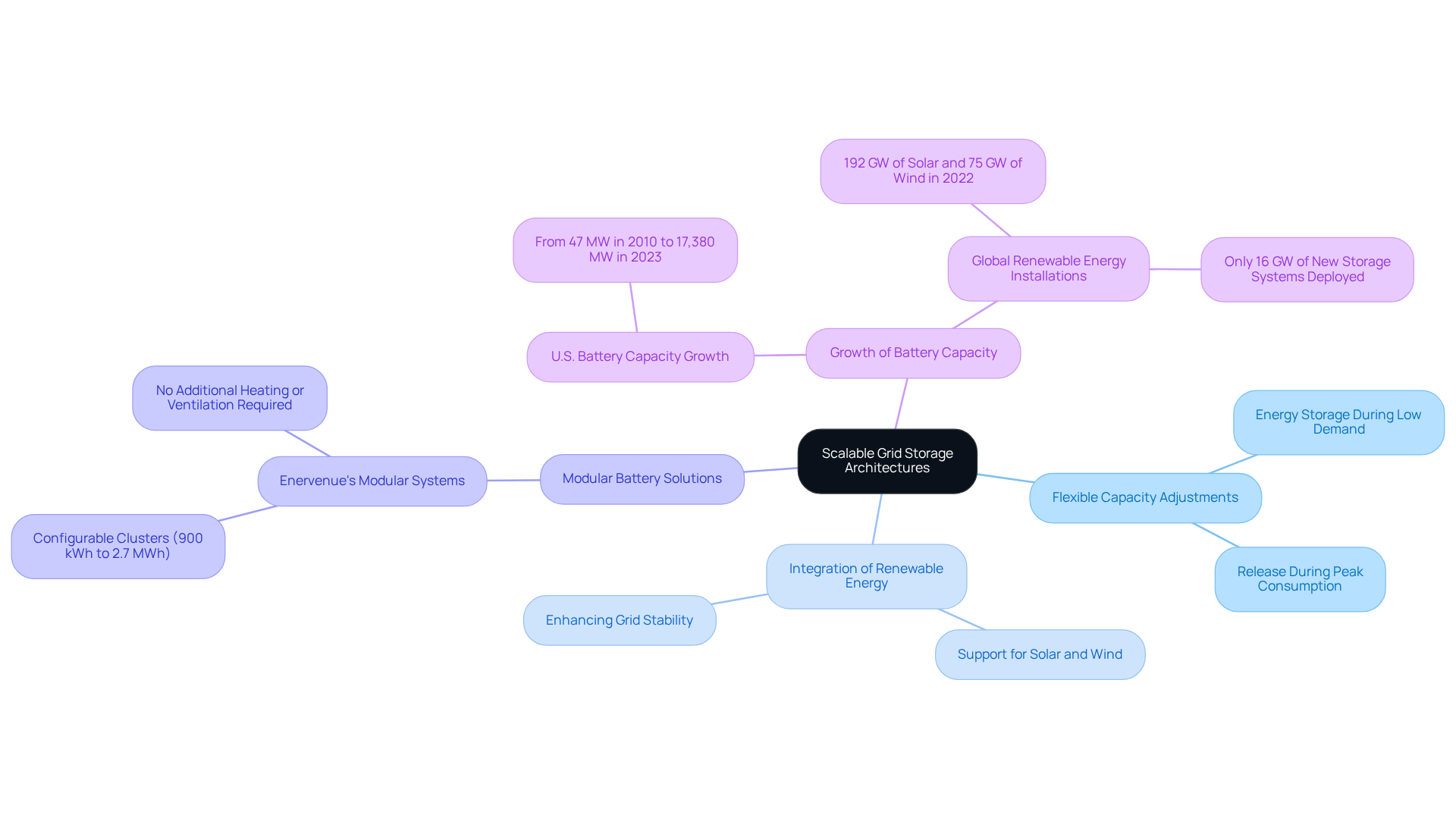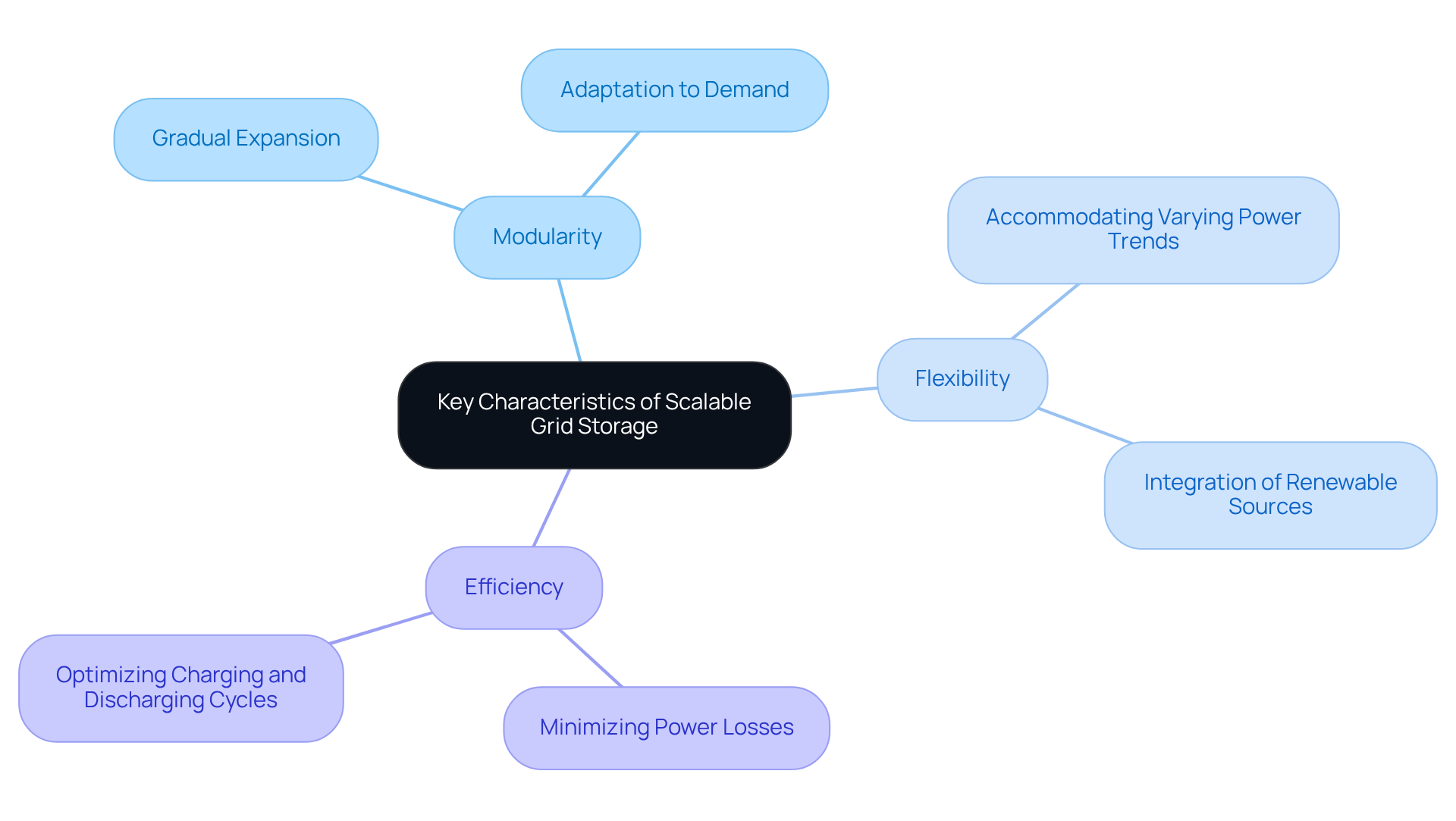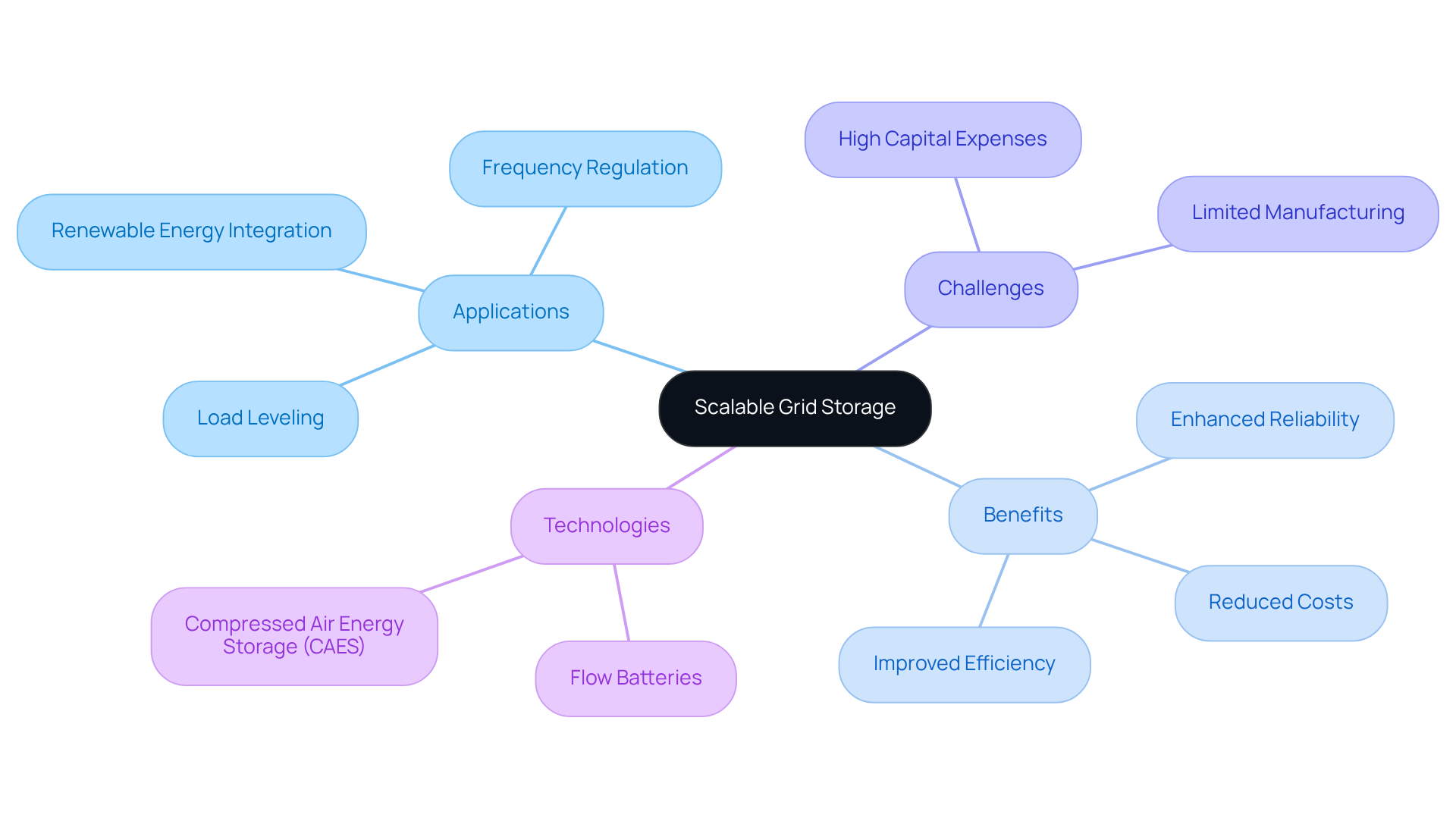Overview
Scalable grid storage architectures are vital for the flexible management of electrical power, facilitating the integration of renewable energy sources while dynamically adjusting capacity to meet demand. These systems play a crucial role in enhancing network stability, improving power efficiency, and significantly reducing operational costs. As we transition to sustainable energy solutions, their importance cannot be overstated.
Introduction
Scalable grid storage architectures are emerging as a cornerstone of modern energy management, facilitating the seamless integration of renewable resources into the electrical grid. These innovative systems not only enhance the reliability and efficiency of power delivery but also provide a flexible solution to meet fluctuating energy demands.
However, as the transition to sustainable energy accelerates, can these architectures truly adapt to the rapid changes in power generation and consumption?
By exploring the evolution, key characteristics, and applications of scalable grid storage, we can uncover both the immense potential and the challenges that lie ahead in shaping the future of energy systems.
Define Scalable Grid Storage Architectures
Scalable grid storage architectures represent a pivotal solution for the flexible storage and management of electrical power, enabling adjustments in capacity according to demand. These systems are crucial for seamlessly integrating renewable energy sources, such as solar and wind, into the electrical grid.
For instance, Enervenue's modular battery solutions can be configured into clusters ranging from 900 kilowatt-hours to 2.7 megawatt-hours, facilitating effective scalability to meet varying power needs. This inherent flexibility ensures that energy can be stored during periods of low demand and released during peak consumption times, thereby enhancing system reliability.
As the share of variable renewable energy increases, the ability to adjust capacity becomes vital for maintaining network stability. Experts emphasize that scalable grid storage architectures not only aid in the integration of renewable resources but also enhance overall power security, positioning them as a strategic asset for the future of energy systems.
Furthermore, the remarkable growth of U.S. battery capacity—from 47 MW in 2010 to 17,380 MW in 2023—underscores the escalating importance of scalable grid storage architectures within the current power landscape.
As Vineet Mittal aptly notes, 'Grid-scale energy retention offers a solution by holding surplus renewable energy produced during off-peak times and delivering it during low generation or high demand.' This observation highlights the critical role of scalable network capacity in achieving Net Zero Emissions by 2050.

Trace the Evolution of Grid Storage Technologies
The evolution of grid energy solutions has its roots in early methods such as pumped hydro systems, utilized since the 1920s. Over the decades, advancements in battery technology, particularly lithium-ion batteries, have revolutionized power retention capabilities. The late 20th century saw the introduction of flow batteries and compressed air power reserves, expanding the array of options for grid-scale retention.
Today, innovations like AI-powered management systems and solid-state batteries are paving the way for more efficient solutions, particularly in scalable grid storage architectures. This historical perspective underscores the continuous drive for improved power retention technologies to meet the escalating energy demands.
Notably, hydroelectric power remains the largest renewable electricity source globally, illustrating the critical role of power retention in facilitating the integration of renewable resources. Furthermore, power retention systems yield significant financial advantages by managing peak demand and optimizing resource utilization, essential for sustaining power infrastructure.
As the sector advances, addressing challenges such as the practical integration of hydrogen as an energy carrier will be crucial for future energy solution developments.

Identify Key Characteristics of Scalable Grid Storage
Scalable grid storage architectures are defined by key characteristics such as modularity, flexibility, and efficiency.
- Modularity allows for the gradual expansion of capacity, enabling structures to evolve in response to demand without requiring a complete redesign.
- This adaptability is crucial for accommodating varying power generation and consumption trends, particularly with the integration of renewable sources.
- Efficiency pertains to the system's ability to minimize power losses during charging and discharging cycles.
Together, these attributes ensure that scalable grid storage architectures effectively meet the dynamic needs of modern power frameworks.

Examine Applications and Benefits of Scalable Grid Storage
Expandable network storage solutions are pivotal in modern power management, enabling applications such as load leveling, frequency regulation, and seamless integration of renewable energy sources. For example, during peak solar production, surplus power can be effectively stored for later use, which significantly diminishes reliance on fossil fuels. Moreover, these networks enhance power reliability by providing backup electricity during outages, ensuring a consistent power source.
The implementation of scalable grid storage architectures yields numerous benefits, such as improved power efficiency, reduced operational costs, and heightened reliability in power delivery. As the power sector advances, these systems are set to play a vital role in facilitating the transition toward a sustainable future for resources. However, challenges such as high capital expenses and limited local battery manufacturing must be addressed to fully unlock their potential.
Recent funding initiatives, including NYSERDA's allocation of over $5 million for innovative power retention technologies, highlight the necessity of advancing scalable grid storage architectures for long-duration power solutions. Technologies such as flow batteries and compressed air energy storage (CAES) are currently under investigation to enhance power retention capabilities.
As Dr. William Acker, Executive Director of NY-BEST, emphasizes, "Long Duration Energy Storage and other innovative energy storage technologies will provide critical services to the electrical grid, supporting reliability, infrastructure efficiency, reducing costs, and enabling our clean energy objectives.

Conclusion
Scalable grid storage architectures embody a transformative solution for managing electrical power, particularly as we integrate renewable energy sources into the grid. Their inherent modularity and flexibility enable capacity adjustments to meet fluctuating demand, ensuring a reliable energy supply while enhancing overall power security.
This article traces the evolution of grid storage technologies, highlighting advancements from early methods like pumped hydro systems to modern innovations such as AI-powered management systems and solid-state batteries. Key characteristics of scalable grid storage—modularity, flexibility, and efficiency—are essential for addressing the dynamic needs of contemporary power frameworks. Furthermore, the applications and benefits of these systems, including load leveling and frequency regulation, underscore their critical role in the transition toward a sustainable energy future.
As the demand for reliable and efficient energy solutions escalates, investing in scalable grid storage architectures becomes imperative. By addressing challenges such as high capital costs and the necessity for local manufacturing, we can unlock their full potential. This investment will ultimately support the global shift toward renewable energy and help achieve ambitious clean energy objectives.
Frequently Asked Questions
What are scalable grid storage architectures?
Scalable grid storage architectures are systems designed for the flexible storage and management of electrical power, allowing adjustments in capacity based on demand. They are essential for integrating renewable energy sources like solar and wind into the electrical grid.
How do scalable grid storage architectures enhance reliability?
These architectures enable energy storage during periods of low demand and release it during peak consumption times, which enhances the reliability of the energy system.
Why is the ability to adjust capacity important?
As the share of variable renewable energy increases, the ability to adjust capacity becomes crucial for maintaining network stability and ensuring a reliable power supply.
What is an example of a scalable grid storage solution?
Enervenue's modular battery solutions can be configured into clusters that range from 900 kilowatt-hours to 2.7 megawatt-hours, allowing for effective scalability to meet varying power needs.
How has battery capacity in the U.S. changed over time?
The U.S. battery capacity has grown significantly, from 47 megawatts in 2010 to 17,380 megawatts in 2023, highlighting the increasing importance of scalable grid storage architectures.
What role do scalable grid storage architectures play in achieving Net Zero Emissions?
They help hold surplus renewable energy produced during off-peak times and deliver it during low generation or high demand, contributing to efforts aimed at achieving Net Zero Emissions by 2050.
List of Sources
- Define Scalable Grid Storage Architectures
- Grid Energy Storage (https://pnnl.gov/grid-energy-storage)
- Clean Energy Storage Facts | ACP (https://cleanpower.org/facts/clean-energy-storage)
- Scaling up global grid-scale Storage to 80GW/year (it was 16GW in 2022) - Energy Post (https://energypost.eu/scaling-up-global-grid-scale-storage-to-80gw-year-it-was-16gw-in-2022)
- Future of Grid-Scale Energy Storage (https://avaada.com/future-of-grid-scale-energy-storage)
- Bringing NASA’s Metal-Hydrogen Batteries to Grid Storage (https://technologynetworks.com/applied-sciences/articles/bringing-nasas-metal-hydrogen-batteries-to-grid-storage-400113)
- Trace the Evolution of Grid Storage Technologies
- 60 Quotes About the Future of Renewable Energy (https://deliberatedirections.com/renewable-energy-quotes)
- Brian Deese Quotes (https://brainyquote.com/quotes/brian_deese_1185961)
- The Top 10 Quotes on Energy So Far in 2013 (https://greentechmedia.com/articles/read/the-top-10-quotes-on-energy-so-far-in-2013)
- Best Quotes of Clean Energy with Page Numbers By r.m. Dell (https://bookey.app/book/clean-energy/quote)
- Examine Applications and Benefits of Scalable Grid Storage
- ABB invests in renewable energy storage specialist HESStec (https://new.abb.com/news/detail/126541/abb-invests-in-renewable-energy-storage-specialist-hesstec)
- Over $5 Million Is Now Available To Support Innovative Energy Storage Solutions - NYSERDA (https://nyserda.ny.gov/About/Newsroom/2025-Announcements/2025-05-22-NYSERDA-Announces-Over-5-Million-To-Support-Energy-Storage)
- Energy storage - IEA (https://iea.org/energy-system/electricity/grid-scale-storage)
- Connected Energy And Forsee Power To Develop Energy Storage (https://connected-energy.co.uk/news/forsee-power-partnership)
- Future of Grid-Scale Energy Storage (https://avaada.com/future-of-grid-scale-energy-storage)




